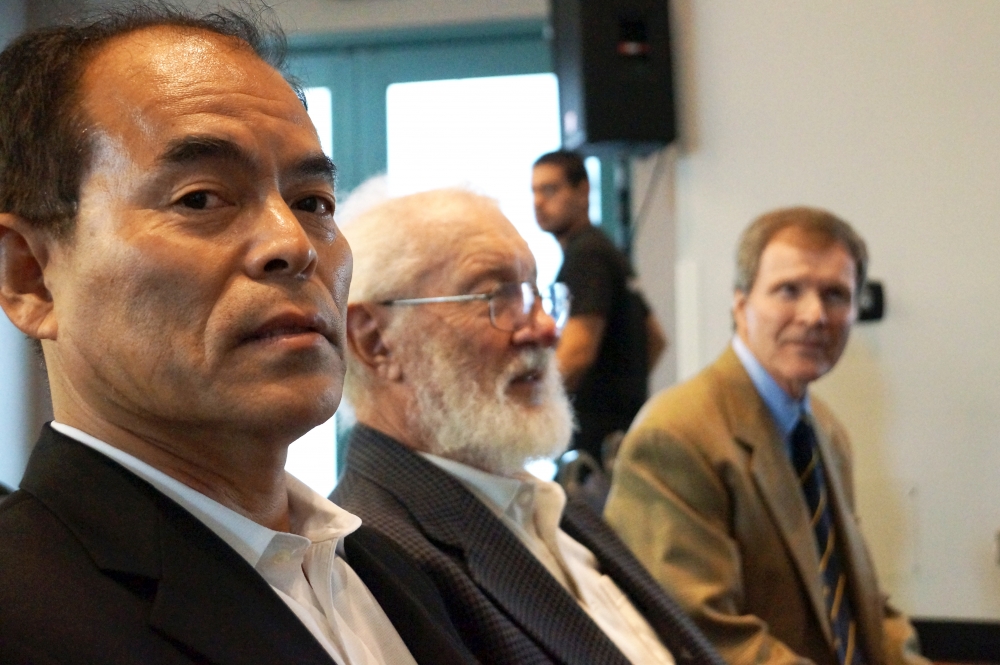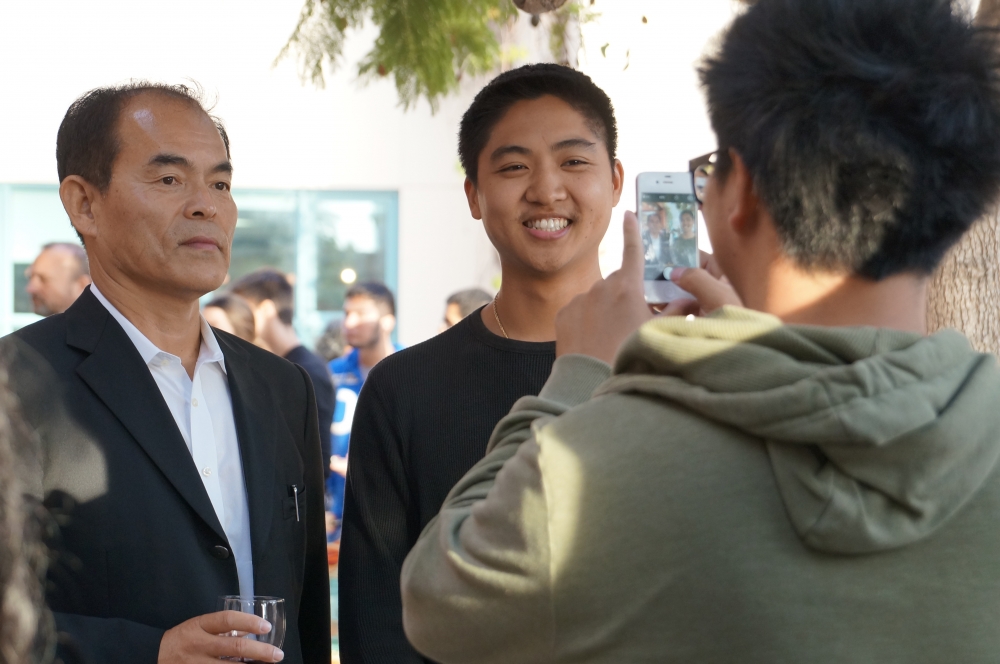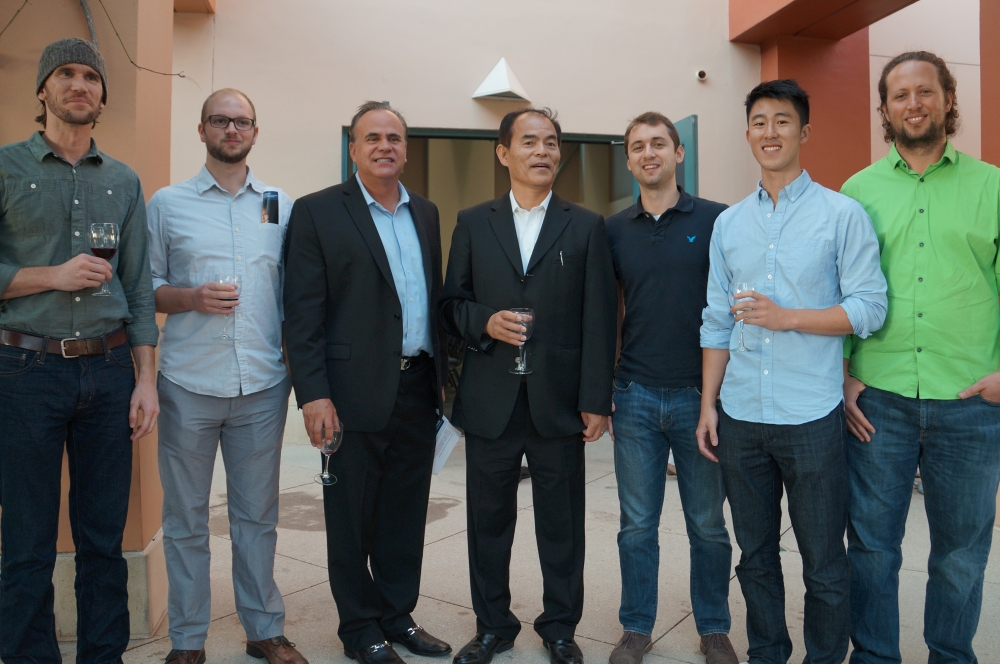Inspiration and Perspiration



When Thomas Edison, credited with the invention of the first practical light bulb, said his famous words about genius, little did he know they would still ring true more than a century later for another lighting breakthrough: the bright blue light-emitting diode (LED) for which UC Santa Barbara professor Shuji Nakamura won the 2014 Nobel Prize in Physics.
“I never expected I would invent the blue LED using GaN,” said Nakamura, at his lecture on Thursday, Oct. 30, as part of the College of Engineering’s celebration of UCSB’s sixth Nobel win.
For decades, Nakamura, his colleagues and competition around the world were striving to find a way to create the highly sought blue LED, whose properties could allow for various applications, such as improvements in the ways machines can read and write data. But the potential that the Nobel committee recognized was how it paved the way for white LED lighting, an energy efficiency breakthrough that could impact the whole world.
Nakamura was bitten by the blue LED-inventing bug in the late 1980s while he was a researcher at Nichia Chemical in Japan, and the odds were already stacked against him. To be commercially viable, his work had to stand out. To be taken seriously, particularly in the United States, Nakamura — who held a master’s degree from Tokushima University — decided he had to get a Ph.D.
“In the United States, if you have a master’s degree, you are still a technician,” he said.
His solution? Gallium nitride (GaN). Only a little research had been done on the semiconductor material for use in LEDs, which meant he could make significant contributions to the science, publishing the five or so papers needed for his “paper Ph.D.” At the same time, his work could garner attention for its use of GaN, which had been known to emit light in the high-frequency violet range.
But there was a reason people were staying away from gallium nitride. Though a contender for the blue LED, the semiconductor material was notoriously difficult to use. The crystals were heavily defective, with irregularities that could dissipate the light, or kill it altogether.
“It’s also very hard to grow,” said Siddha Pimputkar, one of Nakamura’s postdoctoral researchers, whose job is to grow these crystals. Because of the nature of the material, the crystal needs to be grown at an extremely high temperature, near the threshold at which the compound separates into its component gallium metal and nitrogen gas.
Since GaN had all but fallen by the wayside in terms of blue LED research in the late 1980s, there was very little in the way of commercially available technology suited for GaN crystal growth. Use of gallium nitride was actively discouraged, said Nakamura, and those who used it were viewed with doubt and scorn.
“In 1989 they said we would never make a blue LED with GaN,” he said.
Nakamura responded by making his own machine. Taking a conventional — and very expensive — metal organic chemical vapor deposition machine used to grow crystals, he modified it. Nakamura fabricated his own glass parts to withstand the extreme temperatures needed to grow the crystal and to modify the gas flow. Research, test, fail, repeat with new data. Nichia even called him off the project, citing concerns over cost, but he continued to work all day, virtually every day, for about a year and a half, until he found a system that could reliably reproduce, with high quality, a gallium nitride crystal.
With that system perfected, research developments moved at a faster pace. GaN by itself still couldn’t yield a bright enough blue light to be useful or energy efficient enough in ordinary or commercial applications. But, through doping and alloys — particularly with Indium to form InGaN — and building on the research pioneered by UCSB Nobel laureate Herbert Kroemer in the field of heterostructures, Nakamura debuted his high-efficiency bright blue LED in 1993.
Fast forward to today: Things are markedly easier for Nakamura now, as a professor at UCSB. He’s in the company of like-minded researchers at the campus’s Solid State Lighting and Energy Electronics Center, which he co-directs with UCSB materials professor Steven DenBaars. Their research led to the world’s first nonpolar blue-violet laser diodes in 2007.
Nakamura’s discoveries have helped people the world over. High-efficiency bright white LEDS powered by solar cells provide light to people with no electricity, allowing children in even the poorest communities to safely study after a day of school and work; LED technology, used to replace conventional lighting, can reduce power consumption drastically; and the use of LED lighting reduces concurrent greenhouse gas emissions generated by fossil fuels.
Nakamura, however, continues to seek out the challenges and the problems. When asked how he managed to plow through the negativity, the naysayers and the technical obstacles in his early career, it turns out they weren’t so much obstructions to him as they were problems to be solved.
“It’s like a quiz,” he said. “And I like to solve problems. It’s very interesting research.”



